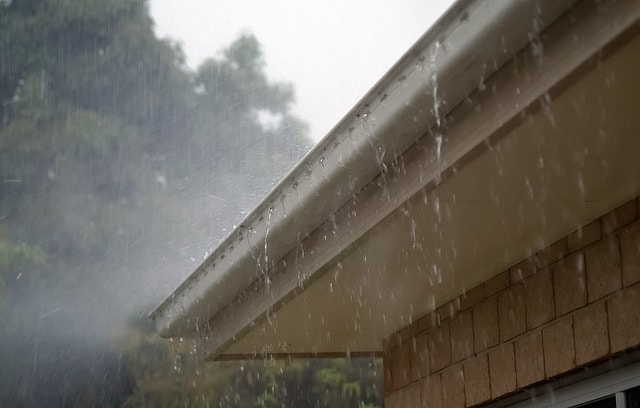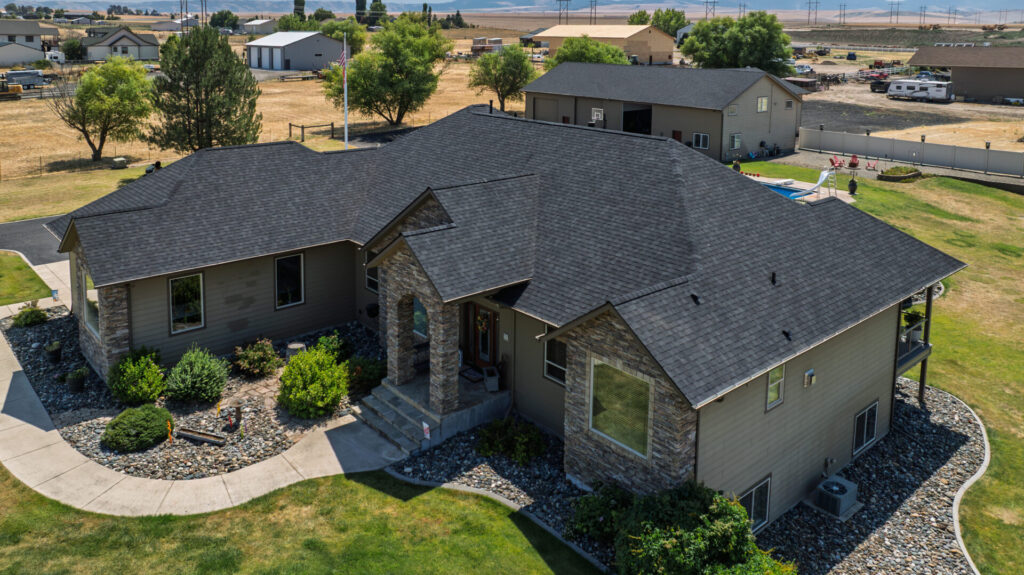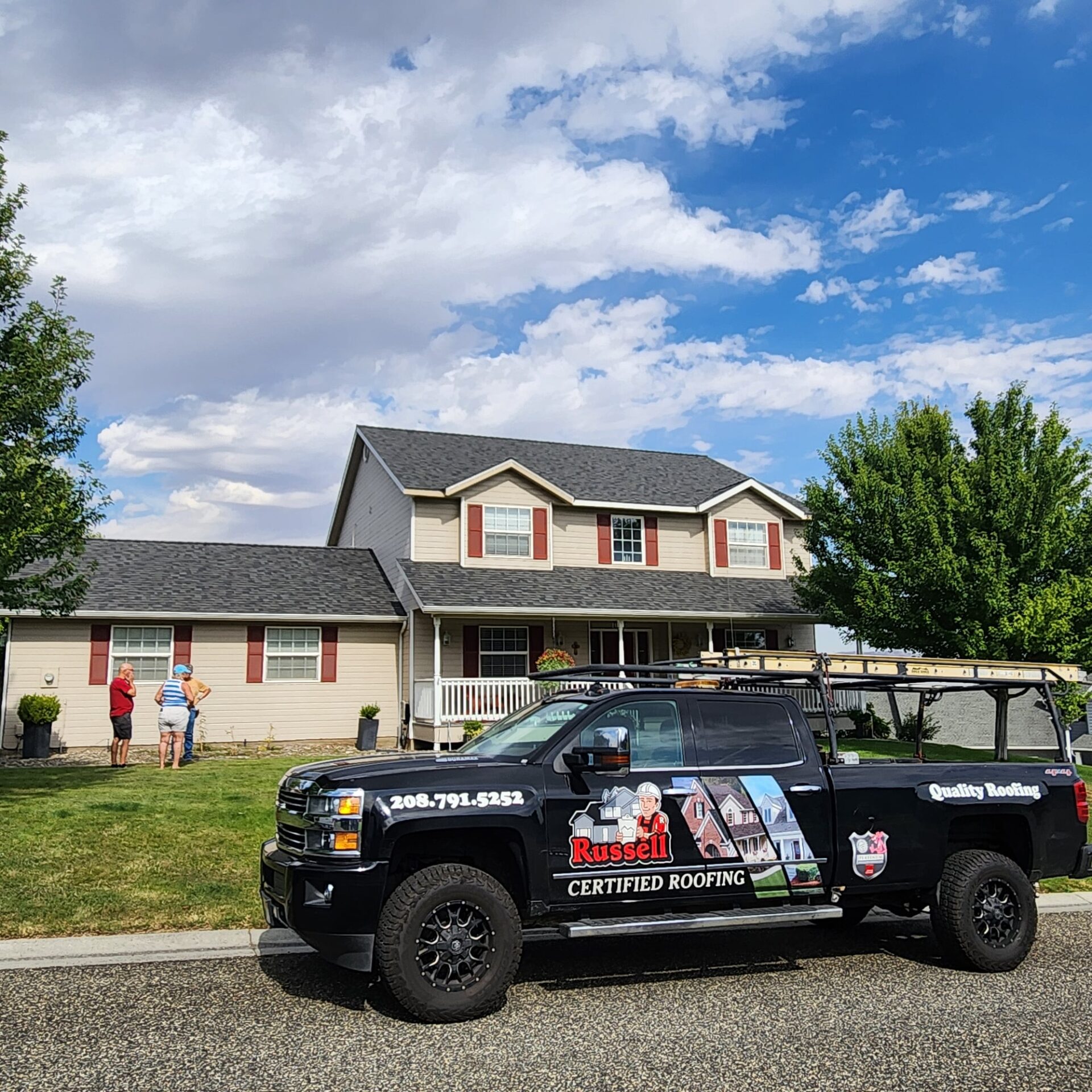The replacement process depends on many factors such as weather conditions and the size and complexity of your roof. Knowing what influences your timeline helps you plan removal, installation, and inspections without unexpected delays. So, let’s review how long roof replacement takes in Lewiston, ID & Spokane Valley, WA!
7 Factors That Determine Roof Replacement Time
Every replacement process is pretty straightforward—removing old materials, inspecting and repairing the deck, installing underlayment, and laying new shingles or panels. However, the average installation time varies depending on several factors, such as the type of roofing material and the crew members.
These seven factors influence the time it takes to replace a roof on your home or business in Lewiston and Spokane Valley, helping you set realistic expectations and plan for potential delays.
 1. Weather Conditions
1. Weather Conditions
For professionally contracted roof companies, roofing work pauses for active rain, unsafe wind, or ice on the deck—not simply because it’s cold. Modern shingles begin bonding on contact, so our crews can replace roofs year-round in the valley as long as the surface is safe and free of ice.
- Rain Delays: Tear-off and installation pause during rain to protect workers, decking, and materials.
- High Winds: Gusts exceeding 25 mph require crews to evacuate the roof until conditions improve.
- Ice Presence: Ice prevents shingles from laying flat and can lead to performance issues as temperatures fluctuate. It also causes unsafe working environments for your contractor.
- Cold Weather: Modern technology allows us to shingle your roof even through the cold weather. We use materials designed for colder temps and adjust our process so work proceeds safely and to spec.
Around October 1st, we switch to a FLEX ice & water shield formulated for colder weather (more flexible with strong adhesion). Our standard underlayment remains the same; we simply adjust the ice & water shield for winter conditions.
Scheduling tip: Checking for a dry weather window still helps with efficiency, but winter installs are common with professional roofers. What stops the job is active precipitation, unsafe wind, or ice, not low temperatures by themselves. Our team will help plan around local conditions so your timeline stays on track.
Monitoring extended forecasts and planning around reliable 72-hour dry windows helps minimize downtime, keeping your roof replacement timeline on track. This is something our team can assist with when scheduling your replacement!
2. Roofing Materials & Design
The type of roofing materials you choose directly affects the time required for roof replacement. Asphalt shingles are installed the fastest, with crews nailing and sealing bundles quickly. Metal panels require precise panel alignment, concealed fasteners, and seam sealing, adding roughly 20–40% more to the installation time.
- Asphalt Shingles: Standard crews can install 100–150 bundles per day.
- Metal Panels: Teams average 1,000–1,500 sq ft/day when fasteners and flashings are prepped.
Roof design features—such as hips, valleys, and custom ridges—require additional flashing and detail work. Each valley or decorative element can add to the hours of installation time. When planning your project, factor in these and other roofing materials & design considerations to get an accurate timeline.
3. Total Roof Area & Complexity
The size and optimal condition of the entire roof are key factors in determining the time required for its replacement. The more complex the roof design is, the longer it will take to replace to ensure structural integrity. Part of this is because our roofers have to take extra safety precautions the further they go off the ground.
A 2,000 sq ft ranch-style home typically takes 1–2 days to complete. A 4,000 sq ft roof with multiple intersecting planes and dormers may require 3–4 days to complete.
- Square Footage Impact: Every additional 500 sq ft can add 4–6 hours of tear-off and installation.
- Complex Layouts: Skylights, chimneys, and valleys require custom flashing, which adds one to two hours each.
- Waste Management: Larger roofs generate more debris, which can extend cleanup by several hours.
Accurate measurements and pre-cutting of underlayment, shingles, and flashing streamline steps on site, reducing the time crews spend adjusting materials and preventing mid-project hold-ups.
4. Roof Pitch & Accessibility
Steep roof pitches and limited access zones increase safety requirements and slow work. A 12:12 pitch (45°) requires harness systems, scaffolding, and easy access, which adds to prep work. Narrow yards or protected landscaping may require smaller deliveries, which can further complicate roofers’ logistics.
- Safety Setup: Installing harness anchors and guardrails can take 1–2 extra hours.
- Material Handling: Lifting bundles by hand or crane adds 15–30% more labor time.
- Site Constraints: Each protective covering for plants or walkways adds cleanup hours.
When evaluating the time required for roof replacement, we will discuss site accessibility and pitch to ensure these setup tasks are included in your project schedule.
5. Crew Size & Experience
The composition of your roofing team significantly impacts the duration of roof replacement. A five-person crew with years of experience can clear old roofing and install new shingles on a 2,000 sq ft home in two days. Smaller or less experienced crews often require additional quality checks and slower pacing, which extends the timeline by 25–50%.
- Experienced Teams: Fewer mistakes mean less rework and quicker progression.
- Larger Crews: Allow simultaneous tear-off, underlayment, and shingle application.
- Training Requirements: New crew members require supervision, which adds to oversight time.
Our Roof Replacement Service has you covered with experienced roofing crews for projects of all sizes.
6. Permit & Inspection Requirements
Local building codes often require both permits and at least one mid-project inspection, which directly affects the time required for roof replacement. Permit applications can take 1–3 days to approve, depending on municipal workload. Inspections—typically conducted after decking and flashing—are usually scheduled to add 1–2 days, depending on the inspector’s availability.
- Permit Lead Time: Our team submits plans early to avoid delays at the front end.
- Inspection Coordination: We then schedule inspections as soon as decking and flashing are complete.
These permits or roof inspections can halt work unexpectedly based on how quickly the city is working, so include these dates in your overall timeline planning.
7. Pre-Existing Damage (Structural Repairs Needed)
When the tear-off reveals pre-existing damage—such as rotten decking, termite damage, or framing issues—we must address these issues before installing new roofing. Replacing decking boards can add half to one full day per major area. Structural reinforcements, such as sistering rafters or adding support beams, may add additional days to the project. Our team completes:
- Roof Deck Replacement: Remove and install new plywood or OSB panels.
- Structural Reinforcement: Sister rafters or reinforce trusses for load support.
- Material Procurement: Special-order lumber and underlayment can result in 1–2 day delays.
A detailed pre-inspection and early ordering of materials reduce the impact of hidden damage on your project’s overall duration.
If you are ready for professional support, our roofing experts deliver complete replacement services—on time and to specification.
 How Long Does It Take to Replace a Roof: Typical Timelines
How Long Does It Take to Replace a Roof: Typical Timelines
Most residential asphalt-shingle roofs in Lewiston and Spokane Valley are replaced within 1–3 days, but for larger projects, it may take a few weeks although this timeframe depends on the square footage and the number of roof features. A simple ranch-style home under 2,000 sq ft with minimal penetrations often finishes in one day. Larger homes or those with multiple roof planes, skylights, or chimneys may need up to three days to complete.
- Day 1: Tear-off and deck inspection begin early; crews remove old materials and assess decking.
- Day 2: Underlayment and flashing go down, preparing the surface for new shingles.
- Day 3: Shingle installation and cleanup, wrap up the project.
Commercial buildings, with their larger footprints and various systems, typically require 3–7 days for installation. Metal roofs or built-up roofing systems require more precise roof installation and may extend the schedule toward the longer end of that range.
For smaller repairs or partial reroofs—such as replacing one section after storm damage—one-day roofing is possible when a focused crew handles 500–1,000 sq ft in under 24 hours.
Note: Please keep in mind that while roof installation typically takes 1–3 days, the lead time for special-order materials may extend your overall schedule.
What to Expect on Day 1, 2 & Beyond
Day 1: Tear-off & Deck Inspection
Our roofers start at first light by removing the old roofing layers down to the decking. They inspect every board for rot or damage, replacing any compromised sections. By midday, the underlayment is ready for roof installation once the deck is secure.
- Key tasks: Remove shingles, underlayment, and flashing.
- Inspection: Check sheathing for moisture, mold, or structural weaknesses.
- Repairs: Replace or reinforce damaged decking panels.
Day 2: Underlayment & Roof Installation
A weather-resistant underlayment covers the entire deck, preventing moisture intrusion under shingles or panels. Flashing around chimneys, vents, skylights, and wall intersections is installed or resealed to ensure watertight channels.
- Underlayment: Roll out and fasten the water-resistant barrier according to the manufacturer’s specifications.
- Flashing: Step and counter-flashing installed at every penetration and transition.
- Preparation: Nail patterns and sealants are checked before proceeding to the next day.
Day 3: Shingle or Panel Installation & Cleanup
On day three, crews lay new shingles or metal panels, nailing and sealing according to industry standards. Every section is inspected for proper alignment and sealing. After installation, crews clear debris, collect nails with magnetic sweeps, and remove waste from the property.
- Installation: Follow manufacturer guidelines for fasteners and overlaps.
- Quality check: The foreman inspects for consistent spacing, tight seams, and a proper seal.
- Cleanup: Magnetic sweep of yard; haul off old materials.
Additional Days: Structural or Decking Repairs
If Day 1 reveals extensive rot or structural issues, expect one additional day for each major repair.
Framing repairs due to structural damage , sistering rafters, or ordering specialty materials can extend the timeline, but they are essential for a durable and safe roof replacement.
Ready to Replace Your Old Roof With a New One?
You now know material lifespans, the factors that affect your schedule, and exactly what each day of replacement entails, so you can move forward with confidence. Contact us today and let us help you replace your roof by scheduling your roof replacement service!
AWARD WINNING PRODUCE
Order Online
Lorem ipsum dolor sit amet, consectetur adipiscing elit. Pellentesque vestibulum aliquam cursus. Mauris molestie aliquam urna. Curabitur nec eleifend risus. Integer eget libero sed elit pharetra ultricies eu in augue. Integer eget libero sed elit pharetra ultricies eu in augue.
BROWSE OUR ITEMS

